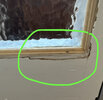Thanks, if it can be fixed, plan is to strip it all back to bare wood again, and re finish it.First off damage like that is often repairable using glue and clamps with timber battens (mitre bond can be particularly effective, but takes preparation care and speed). If thought necessary, rebates can be further strengthened by glueing a small strip of linen across the split after repairing it
Dents can often be steamed out with a damp tea towel and a medium to hot iron. This will swell the crushed fibres which must then be left 24 to 48 hours before a second try is made (if necessary), or the area is sanded/refinished. I've done just such a "fix" on a massive solid oak door which was dropped on its' corner. I didn't get all of the bruises out, but it is almost indiscernable after staining and polishing, and so will pass muster
The biggest problem may be getting any repairs to the finishes ro blend in
You are using an out of date browser. It may not display this or other websites correctly.
You should upgrade or use an alternative browser.
You should upgrade or use an alternative browser.
Getting fed up :( old Victorian door glazing replacement
- Thread starter IanM18
- Start date
Sponsored Links
That’s a good idea, I’ll have to go around the whole install and try and punch the pins down below the surface of the beading, without breaking the glass!When tapping pins in to window beading, I often/usually hold the end of a panel saw against the glass, so if I do miss-hit I hit the flat of the saw not the glass. Final tiny tap with a set afterwards if it needs it.
D
Deleted member 174758
Cut the pins flush before you start if you can - there are side cutters available which don't have a bevel on the outside of the jaws and can do this.That’s a good idea, I’ll have to go around the whole install and try and punch the pins down below the surface of the beading, without breaking the glass!
Ok, time for some photos. Looking for thoughts on if I’m being reasonable or not wanting to withhold to cover the damage caused.
He is suggesting this level of damage is expected when replacing glazing.
Have also attached some photos of the workmanship, not added them all, lots where the beading doesn’t meet, and raised pins.
what’s everyone’s thoughts?
I just want to put this in the rear view mirror, get someone else to fix all the mess, and then I’ll arrange for repair/refinishing of the door.
Or, am i being unreasonable? He removed the old glass with a multi tool & blade and hammer so I can understand how the damage has happened. Everyone else said they would have simply used a sharp chisel to remove the old putty, may have taken longer, but it wouldn’t have caused as much damage.
He is suggesting this level of damage is expected when replacing glazing.
Have also attached some photos of the workmanship, not added them all, lots where the beading doesn’t meet, and raised pins.
what’s everyone’s thoughts?
I just want to put this in the rear view mirror, get someone else to fix all the mess, and then I’ll arrange for repair/refinishing of the door.
Or, am i being unreasonable? He removed the old glass with a multi tool & blade and hammer so I can understand how the damage has happened. Everyone else said they would have simply used a sharp chisel to remove the old putty, may have taken longer, but it wouldn’t have caused as much damage.
Attachments
-
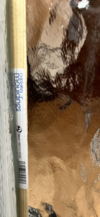 IMG_7495.png1.8 MB · Views: 78
IMG_7495.png1.8 MB · Views: 78 -
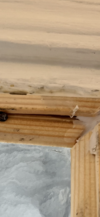 IMG_7493.png1.4 MB · Views: 63
IMG_7493.png1.4 MB · Views: 63 -
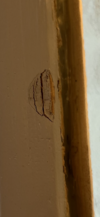 IMG_7492.png1.3 MB · Views: 66
IMG_7492.png1.3 MB · Views: 66 -
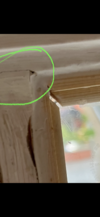 IMG_7491.png932.9 KB · Views: 60
IMG_7491.png932.9 KB · Views: 60 -
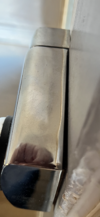 IMG_7489.png1.4 MB · Views: 61
IMG_7489.png1.4 MB · Views: 61 -
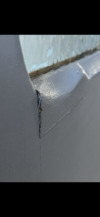 IMG_7488.png1 MB · Views: 66
IMG_7488.png1 MB · Views: 66 -
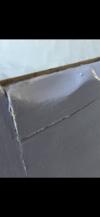 IMG_7487.png1 MB · Views: 57
IMG_7487.png1 MB · Views: 57 -
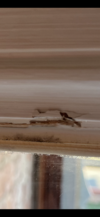 IMG_7486.png1.3 MB · Views: 63
IMG_7486.png1.3 MB · Views: 63 -
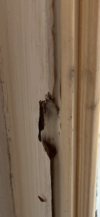 IMG_7485.png1.4 MB · Views: 65
IMG_7485.png1.4 MB · Views: 65 -
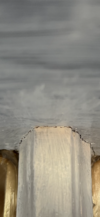 IMG_7483.png1.3 MB · Views: 71
IMG_7483.png1.3 MB · Views: 71
Sponsored Links
It won’t let me post my laughing emoji …. 
I totally get that removing glass may lead to some damage, I’m not a crazy person, but damage to areas outside of where the glass sits is mind boggling. You can see where he’s missed while hammering, or the multi tool has slipped.
The locksmith was well impressed with him even managing to bend the lock out a few mm on the door, like how does that even happen?
I totally get that removing glass may lead to some damage, I’m not a crazy person, but damage to areas outside of where the glass sits is mind boggling. You can see where he’s missed while hammering, or the multi tool has slipped.
The locksmith was well impressed with him even managing to bend the lock out a few mm on the door, like how does that even happen?
That is not a professional job (ie worth paying for)- more like a poster child for DIY gone wrong. How much did he charge?
D
Deleted member 174758
A few thoughts about this:-
Your tradesman obviously doesn't understand the need to match the size of any replacement beading to the original (and for that matter the advisibility of cleaning off any labels, pencil marks, etc as well as the need to prime or stain any "raw" timber before installation). Original (old) glazing often has quite delicate mouldings which simply cannot be reproduced in timber (by machining) hence why putty still has its' uses
Your man really doesn't have a clue how to cut mitre joints which are tight and clean. That should be a "stock in trade" skill for a carpenter or glazier. No excuses
He is also a bit handy swinging a hammer (badly). Now we all have accidents from time to time, but surely if you dent or abrade work you need to correct your error? (techniques: 2-pack filler and some judicious machine sanding on painted work, a damp cloth and a hot iron on clear lacquered work - both will minimise how bad the damage looks). As to cracks, etc - well they are often unavoidable on old windows or panelling and when I do sash window refurbs I always state catagorically before commencing that in 80 to 90% of jobs the window is going to need to have cracks stopped and to be repainted. So your cracked paintwork is probably unavoidable, in at least some of those cases
TBH I am on a combination of conservation work and new installs on a listed building at the moment. My multitool is probably one of the handiest pieces of kit I have in my site kit when I am refurbishing/renovating, but there are times when it shouldn't be used, or at least it needs to be used with extreme caution. Things like chips, cracks bruises, etc are all relatively minor issues which he should have known the fixes for - and applied them. But his inability to cut and fit mitres and the slovenly way he installs stuff is what really gets me. Yes, a level of damage is to be expected, but surely it's his job to correct his own errors and any minor damage and not leave it up to some hapless painter and decorator?

Because it is used sideways on to the glass there is less chance of damaging the glazing beads than if you use a standard bench chisel. I think I still have mine somewhere - and I'm a chippy
Your tradesman obviously doesn't understand the need to match the size of any replacement beading to the original (and for that matter the advisibility of cleaning off any labels, pencil marks, etc as well as the need to prime or stain any "raw" timber before installation). Original (old) glazing often has quite delicate mouldings which simply cannot be reproduced in timber (by machining) hence why putty still has its' uses
Your man really doesn't have a clue how to cut mitre joints which are tight and clean. That should be a "stock in trade" skill for a carpenter or glazier. No excuses
He is also a bit handy swinging a hammer (badly). Now we all have accidents from time to time, but surely if you dent or abrade work you need to correct your error? (techniques: 2-pack filler and some judicious machine sanding on painted work, a damp cloth and a hot iron on clear lacquered work - both will minimise how bad the damage looks). As to cracks, etc - well they are often unavoidable on old windows or panelling and when I do sash window refurbs I always state catagorically before commencing that in 80 to 90% of jobs the window is going to need to have cracks stopped and to be repainted. So your cracked paintwork is probably unavoidable, in at least some of those cases
TBH I am on a combination of conservation work and new installs on a listed building at the moment. My multitool is probably one of the handiest pieces of kit I have in my site kit when I am refurbishing/renovating, but there are times when it shouldn't be used, or at least it needs to be used with extreme caution. Things like chips, cracks bruises, etc are all relatively minor issues which he should have known the fixes for - and applied them. But his inability to cut and fit mitres and the slovenly way he installs stuff is what really gets me. Yes, a level of damage is to be expected, but surely it's his job to correct his own errors and any minor damage and not leave it up to some hapless painter and decorator?
No, not at all. In fact there is a specific, relatively cheap tool made for the job of putty removal which every glazier should carry in his kit, the leather handled hacking knife:IanM18 said:....am i being unreasonable? He removed the old glass with a multi tool & blade and hammer so I can understand how the damage has happened. Everyone else said they would have simply used a sharp chisel to remove the old putty, may have taken longer, but it wouldn’t have caused as much damage.
Because it is used sideways on to the glass there is less chance of damaging the glazing beads than if you use a standard bench chisel. I think I still have mine somewhere - and I'm a chippy
Last edited by a moderator:
@JobAndKnock is spot on. That level of damage with no signs of repair is absolutely not acceptable. Withhold all payment and get the boss round. If he's the boss, google the cost on making up the glazing and offer him that plus 20%.
He is the boss, sole trader.
I’ll be honest, I don’t want him back to fix the installation of the glazing, I’ll take that hit again if I have to and pay someone else to fix his mess. I don’t have any faith in his skills not to make things worse.
What I do want though is to cover the cost of repairs and refinishing to the door and replacing the lock.
I’ll be happy with taking the cost of repairs off his bill, and drawing a line under it.
Cost of the lock, door repairs, and re decorating the door are probably close to his invoice cost anyway.
Assuming he will have public liability insurance of some kind
I’ll be honest, I don’t want him back to fix the installation of the glazing, I’ll take that hit again if I have to and pay someone else to fix his mess. I don’t have any faith in his skills not to make things worse.
What I do want though is to cover the cost of repairs and refinishing to the door and replacing the lock.
I’ll be happy with taking the cost of repairs off his bill, and drawing a line under it.
Cost of the lock, door repairs, and re decorating the door are probably close to his invoice cost anyway.
Assuming he will have public liability insurance of some kind
DIYnot Local
Staff member
If you need to find a tradesperson to get your job done, please try our local search below, or if you are doing it yourself you can find suppliers local to you.
Select the supplier or trade you require, enter your location to begin your search.
Please select a service and enter a location to continue...
Are you a trade or supplier? You can create your listing free at DIYnot Local
Sponsored Links


